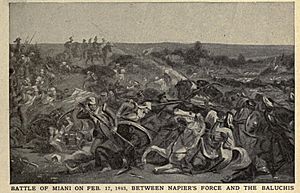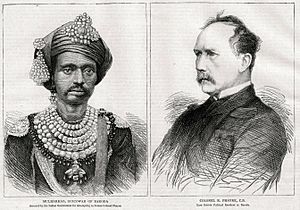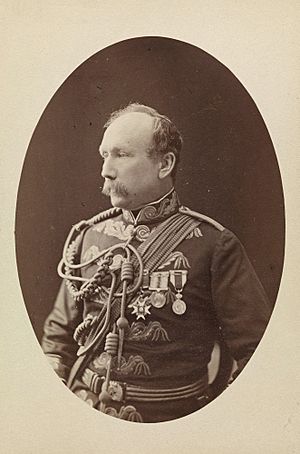Robert Phayre (Indian Army officer) facts for kids
General Sir Robert Phayre (born January 22, 1820 – died January 28, 1897) was an important General in the British Indian Army. He spent most of his military career in India. He fought in several major conflicts, including the First Afghan War, the Second Anglo-Afghan War, and the Indian Rebellion of 1857. From 1873 to 1874, he was a British representative, called a Resident, in a place called Baroda. During this time, the local ruler, Maharaja Malhar Rao, tried to poison General Phayre. He put arsenic and diamond dust in Phayre's drink!
Contents
Early Military Adventures

Robert Phayre was born in Shrewsbury, England. He went to Shrewsbury School. He joined the East India Company's army on January 26, 1839. He became a lieutenant in 1840.
He served in the First Anglo-Afghan War. He fought against the Baloch people in December 1840. He was even mentioned in official reports for his bravery. In 1843, he fought in the Sindh War. He was badly wounded during the Battle of Miani. Sir Charles James Napier praised him for his courage.
In 1844, Phayre became an Assistant Quartermaster-General in Sindh. This job involved planning and organizing supplies for the army. From 1851 to 1856, he worked on clearing mountain roads in Southern Mahratta country. He also helped with the Anglo-Persian War in 1856-1857.
In March 1857, he became the Quartermaster-General for the Bombay Army. He kept this role during the Indian Rebellion of 1857, also known as the Indian Mutiny. His work was highly praised by Sir Hugh Rose. Phayre held this important position until 1868. He was promoted to major in 1857.
He became a lieutenant-colonel in 1863 and a full colonel five years later. He also took part in the British Expedition to Abyssinia. He was again mentioned in official reports. He received an award called the C.B. and became an aide-de-camp to Queen Victoria.
The Baroda Problem

From 1868 to 1872, Phayre was in charge of the Sindh frontier. In March 1873, he became the British Resident at Baroda. This meant he was the main British official there.
Phayre reported that the local ruler, Maharaja Malhar Rao, was being very cruel and unfair to his people. These reports started what was known as the Baroda Crisis. A special group investigated Phayre's claims and found them to be true.
The Maharaja was warned to change his ways, but things did not get better. The tension between Phayre and Malhar Rao grew. On November 9, 1874, someone tried to poison Phayre. They put arsenic and diamond dust in his drink, a sherbet.
After this, Malhar Rao was removed from power on April 10, 1875. He was sent away to Madras and died there later. A new, more modern ruler, Sayajirao Gaekwad III, took his place. Even though Phayre's reports led to these changes, the British government decided to replace him as Resident. Sir Lewis Pelly took over on November 25, 1874.
Fighting in the Second Afghan War
After leaving Baroda, Phayre returned to military command. He led a brigade in Bombay and then in Rajputana from 1875 to 1880. He became a Major-General on January 1, 1880.
He was then put in charge of the reserve army during the Second Anglo-Afghan War. His job was to secure the supply route to Kandahar. After a big defeat at the Battle of Maiwand on July 27, 1880, Phayre was ordered to rush to Kandahar. The city was under attack by Ayub Khan.
However, Phayre was delayed because he didn't have enough soldiers or supplies. General Frederick Roberts arrived first and saved Kandahar at the Battle of Kandahar before Phayre could get there. Phayre was still mentioned in official reports and received an award, the K.C.B., and the medal.
Later Life and Legacy
From 1881 to 1886, he commanded a division of the Bombay Army. When he retired, the Bombay government praised his long service. He became a Lieutenant-General in 1881 and a full General in 1889. In 1894, he received the highest honor, the G.C.B..
General Phayre was also very involved in religious and charity work. He wrote several books and pamphlets about his faith. He died at his home in London on January 28, 1897. He was buried in Brookwood Cemetery.
Family Life
In 1846, Robert Phayre married Diana Bunbury Thompson. They had four children: two sons, Robert and Arthur Phayre, and two daughters, Anna Maria Phayre and Caroline Emily Phayre.
His son, Robert Phayre, joined the Indian Civil Service. He sadly died fighting rebels in Upper Burma in 1886. Another son, Colonel Bernard (Robert) Phayre, became a commanding officer in India. He won a medal for bravery during World War I.



